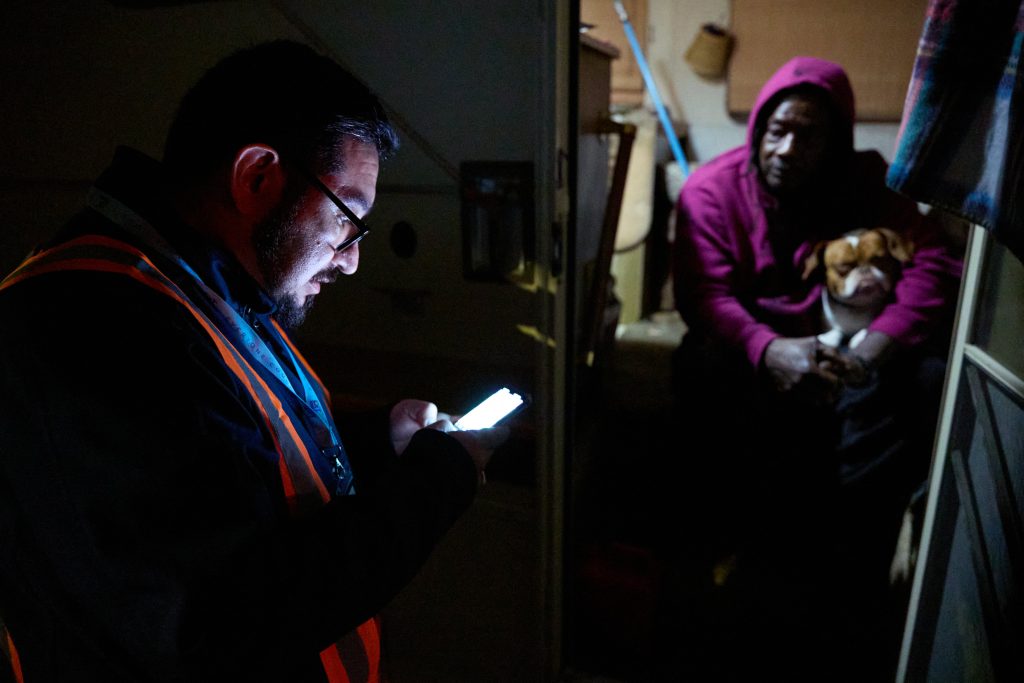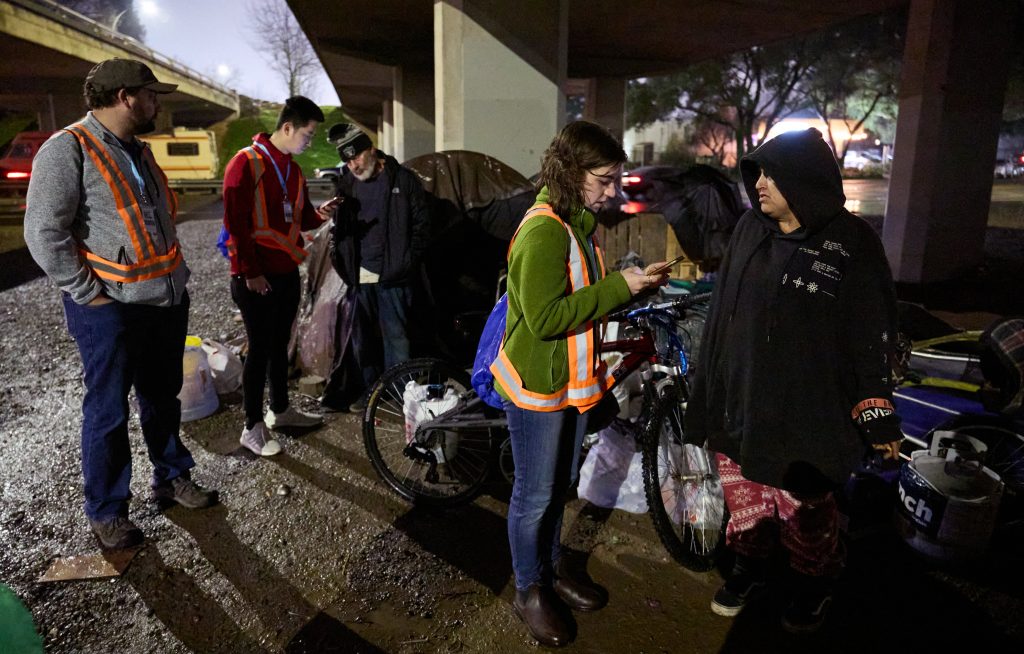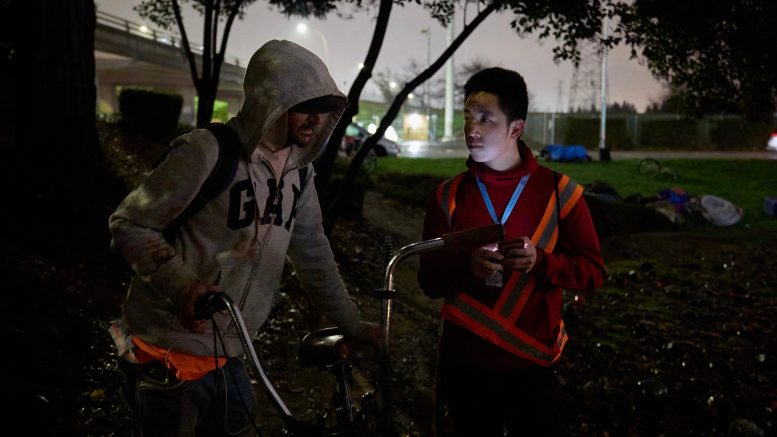By Chris Nichols and Keyshawn Davis
Heather Coffman says she left her home nearly two decades ago to escape the domestic violence that shattered her family.
“It was my parents. I didn’t have a choice in the matter,” Coffman explained, standing barefoot near her tent under Highway 50 at Howe Avenue in Sacramento. “I didn’t want to be part of it no more, so I had to leave.”
Coffman, 42, a Rancho Cordova native, spoke with volunteers from the Sacramento County homeless Point-In-Time Count Wednesday night. The biennial survey, which continues Thursday in neighborhoods, parks and along riverbanks countywide, does more than just tally the region’s unhoused residents. It also asks them how long they’ve lived on the streets, where they’re from and what caused their homelessness.
Organizers say the goal is to learn who is unhoused and why so the Sacramento region can better align its homeless funding and services. The results of the count are used to determine state and federal funding for the county’s homeless shelters and other services.
Meeting the challenge in Sacramento, where rents have skyrocketed and homeless camps are commonplace, won’t be easy.

“I can’t find affordable housing,” Charlie Sims, 59, who lives in an RV under Highway 50, told volunteers. “But I ain’t gave up yet. I’m gonna keep trying.”
Sacramento Steps Forward runs the count locally. The nonprofit expects to release a report this spring that estimates the county’s total unhoused population and paints a picture of who is homeless in the county. The last survey in 2022 found Sacramento County’s homeless population had soared to a record 9,300 people, up a dramatic 67% from the previous count in 2019.
Despite greater regional coordination and the recent opening of new homeless shelters and housing communities, officials say they don’t expect to see a decline in Sacramento County’s overall homeless population.
Officials say that’s because the root causes of homelessness haven’t been solved. For every person who gained housing in recent months, an estimated three more fell into homelessness, according to Sacramento Steps Forward.
“I think the important information we’re trying to find out is what were the sources [for] the influx of homelessness,” said Sacramento City Council member Eric Guerra, who took part in the count. “Was it out of housing? Was it out of employment? Was it out of the correctional system? Falling off your mental health plan?”
Standing under the freeway in the rain-soaked mud Wednesday night, Coffman said she’s been homeless, off and on, since 2006. But she recently connected with an outreach worker who’s trying to place her at the Outreach and Engagement Center, a Sacramento city-funded shelter, she said.
“I’ve been out here a long time, and I don’t want to be out here no more,” Coffman added, noting she’s been sober for two years, but recently lost her mother and found out she’s suffering from congestive heart failure. “I don’t want to die out here. It’s pretty close because I’m having a hard time with it.”
“Bring some empathy”
Approximately 800 volunteers registered to take part in the count. Many of them gathered at Sacramento State’s Harper Alumni Center before being deployed to different survey locations across the county.
“We’re there to count, but we’re also there to show some compassion and meet with these people and bring some empathy back to our citizens in our community,” said Brian Pedro, director of Sacramento’s department of community response, which includes teams of homeless outreach workers.
During the survey, volunteers asked what Sacramento can do better to help the unhoused community. Several homeless residents said empathy was a good starting place.
Alicia Garcia, who also lives under the 50 freeway, said she’s been unhoused since 2019 when her fiance was murdered at a light rail station.
The 45-year-old said one of the struggles of being homeless is that it feels like no one is trying to fight for them.

“We don’t have a bathroom close by,” Garcia said. “We got to go down the way to go to the outhouse. These restaurants don’t even want to mess with us. We get people coming by here with paintballs shooting at us. People have been throwing things over the freeway, lighting our tents on fire. All they do is throw us out. We get in trouble for the vandalism.”
Garcia said there should be more resources like water, food and electricity so unhoused residents can stay warm during the cold.
“They don’t care,” she said. “We have to go from here to about Home Depot to get water, or sneak into the apartments to try and get water. Have something where we can charge our phones or our adapters or lights.”
Garcia said they can’t start fires outside to stay warm because the city will fine them.
“We tie a string to a tree, we get a $1,000 fine,” she said. “Where are we gonna get $1,000? We can’t even get $1,000 to get into a home.”
Contact CapRadio reporter Chris Nichols at chris.nichols@capradio.org
Contact Solving Sacramento reporter Keyshawn Davis at keyshawn@solvingsacramento.org
This story is part of the Solving Sacramento journalism collaborative. Solving Sacramento is supported by funding from the James Irvine Foundation and James B. McClatchy Foundation. Our partners include California Groundbreakers, Capital Public Radio, Outword, Russian America Media, Sacramento Business Journal, Sacramento News & Review, Sacramento Observer and Univision 19.



I keep reading about how it’s cheaper for local governments to house people than to pay for all the expenses from sweeping people’s tents and stealing all their stuff every time some neighbor gets upset and submits an anonymous complaint. Before acting on such complaints, the complainer should have to actually talk to the homeless person/s and describe the conversation to city staff.
And the city should have already provided an audit of all the money they are spending on not solving the problem but instead playing whack-a-mole and blaming the victims. I don’t understand why chambers of commerce aren’t able to fix this market failure but instead come whining to city and county electeds. So lame.